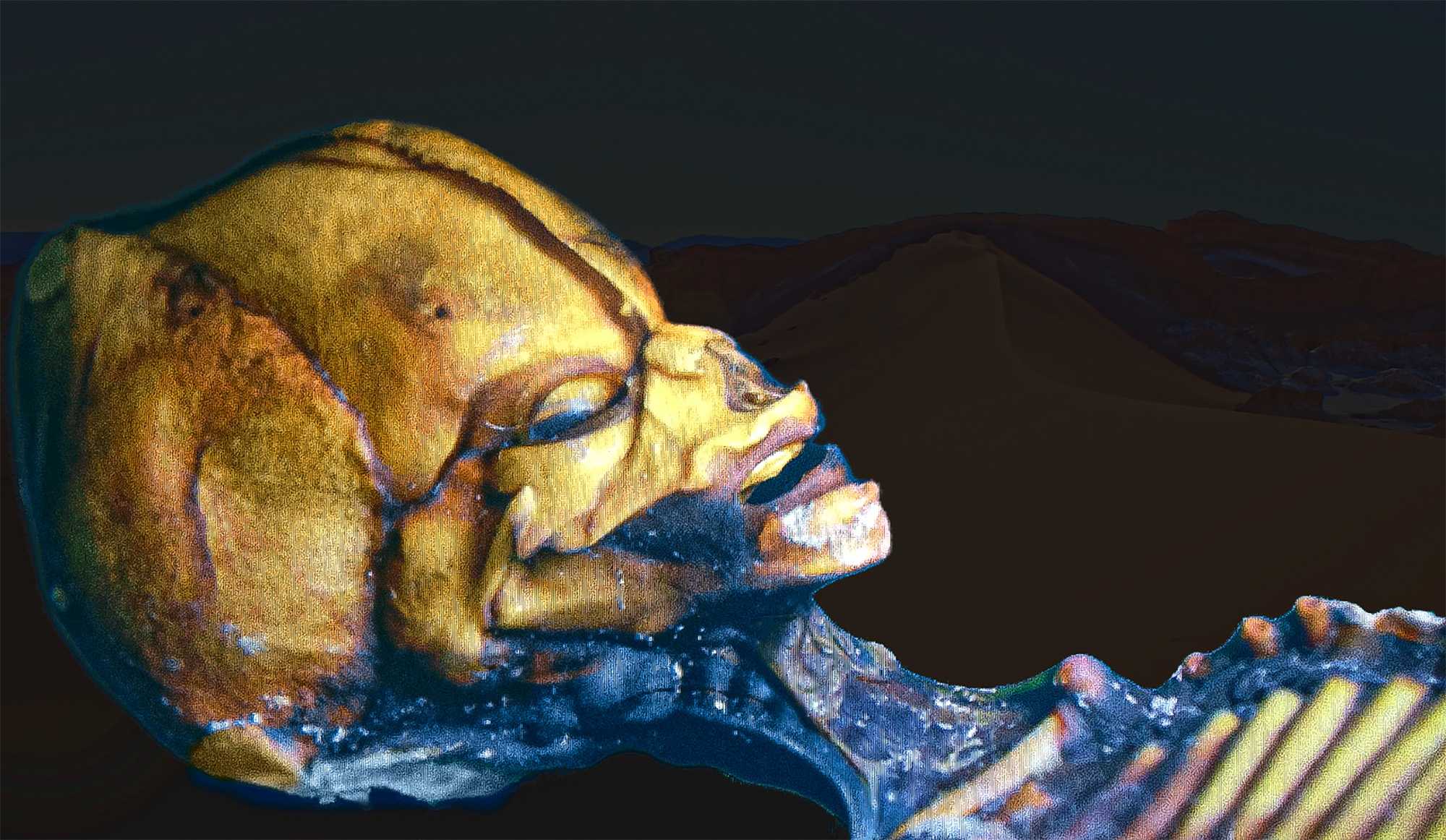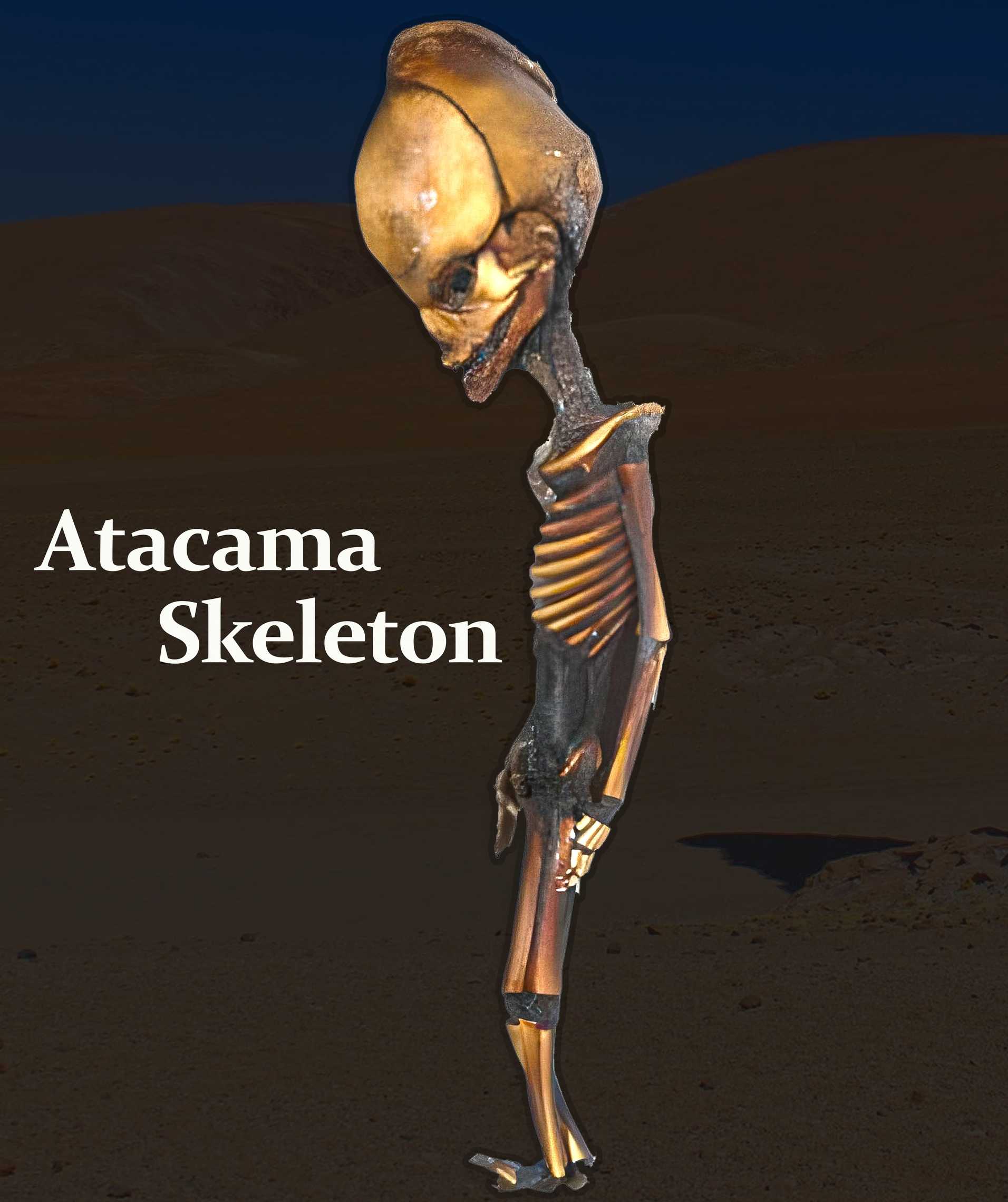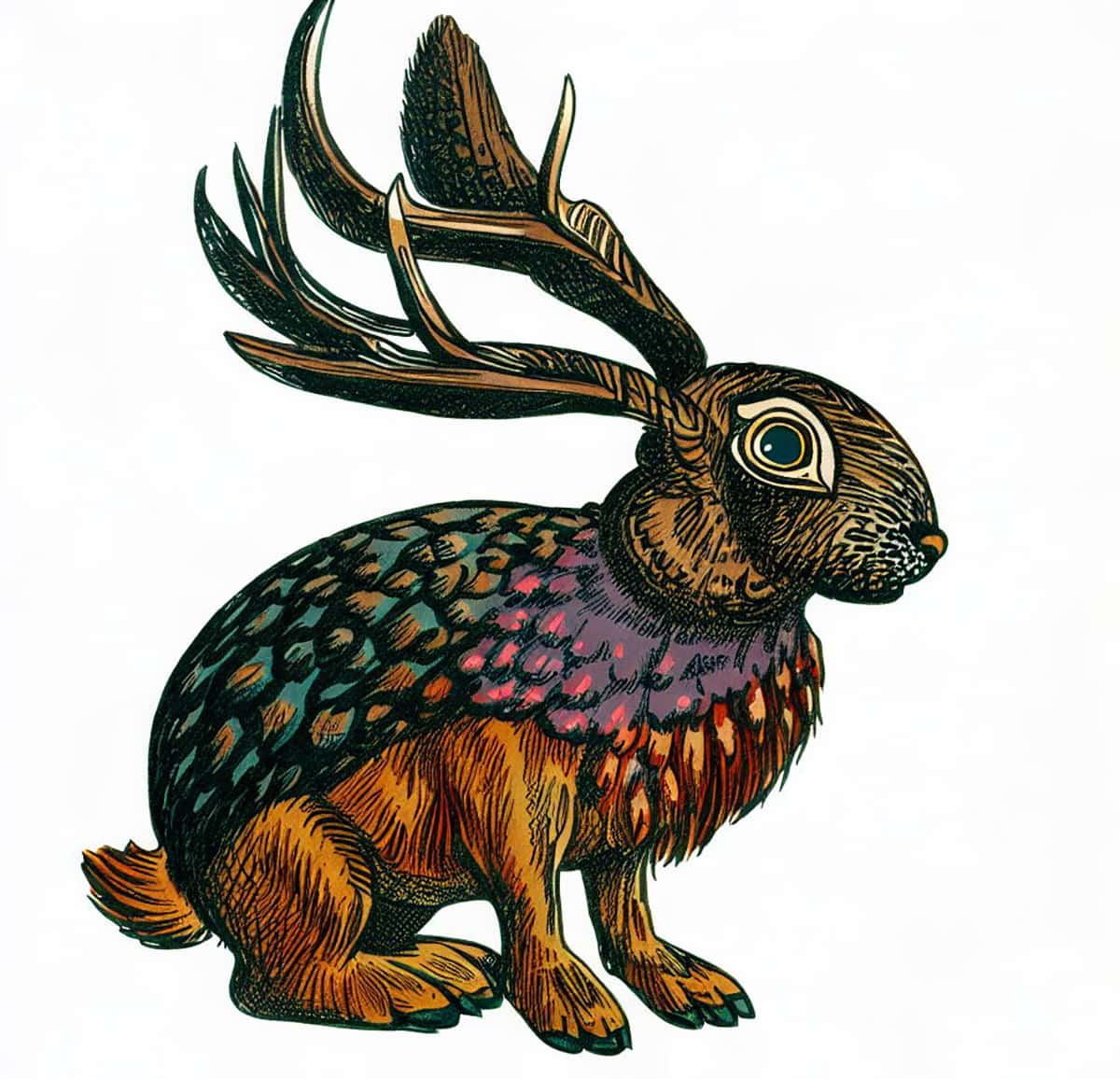The Atacama Skeleton was found in the Atacama Desert of Chile in 2003. The local people refer to him as the humanoid of Atacama, or just Ata. Its skull is shaped like “extraterrestrial” imagery, and it is only 6 inches in length (15 cm). It was conclusively determined to be human by genetic testing conducted at Stanford University at the year’s conclusion in 2012. Genomic testing performed in 2018 confirmed that the mummy belonged to a stillborn or preterm female infant, affected by abnormalities and early skeletal development.
This is similar to the case of Alyoshenka, an alien-like being amidst Russian desolation.
Finding of the Atacama Skeleton
Local Chilean newspaper La Estrella de Arica reported that on October 19, 2003, a man called Oscar Muñoz discovered the Atacama Skeleton while digging for artifacts in the desert village of La Noria in the Atacama region, a ghost town near Iquique, Chile.
About six inches in length, Muñoz found “a strange skeleton the size of a pen” outside an abandoned chapel. It was wrapped in white fabric and tied with a purple ribbon. It was a toothy beast with a peculiar bump on top of its dome-shaped skull—a sign of a cloverleaf skull symptom.

Its skin was black and scaly. She was built differently than the average person, with just 10 sets of ribs instead of 12. The Atacama Desert is one of the world’s driest places to visit, along with the Antarctic Plateau. The quantity of salt in it is excessive. It’s possible that this is what made mummification and subsequent preservation possible for the Atacama Skeleton.
Muñoz presented the skeleton to a colleague of his named Alejandro Davalos, who took the first photograph of it. Ufology group AION received the images taken by Davalos. After returning to Iquique a few days later, Muñoz sold the skeleton to a businessman, who is a long-time customer of his, for the low, low price of 30,000 Chilean pesos (about $60 USD).
The northern agent for AION, Mario Pizarro, claimed that the Atacama Skeleton may be resold for 80 million Chilean pesos ($160,000). Meanwhile, the skeleton’s new owner wants 500,000 Chilean pesos ($550) for one picture and 750,000 ($850) for two.
Identifying the Atacama Skeleton
The case quickly gained attention on Chilean television. The Chilevisión channel, which conducted extensive research into the Atacama Skeleton, traveled to the area with a group of ufologists and paranormal investigators.
The idea that this “thing” could be an alien was completely off the table for some investigators. For instance, a marine biologist from a Chilean university already confirmed the thing to be an aborted human pregnancy, solely by examining the images of the creature.
The American immunologist Garry P. Nolan published a data set in March 2018 that suggested the person also had mutations in genes related to dwarfism, scoliosis, and musculoskeletal anomalies in addition to an uncommon bone aging condition.
There have never been reports of detecting so many mutations that especially impair skeletal development, yet researchers have found 64 unique mutations in 7 genes relevant to the skeletal system. The Atacama Skeleton’s ancestry was even traced back to the Chilean island of Chiloé.
Examining the Atacama Skeleton
The Atacama Skeleton was allegedly determined to be a fetus in an x-ray scan conducted by Doctor Pilar Manchón of a radiology center in Barcelona. Since this radiologist has never verified these claims or published them, they are still unsubstantiated.

The University of the Basque Country conducted research on the object, and their findings indicated that it was really a mummified fetus. Prof. of forensic medicine at the University of the Basque Country, Dr. Francisco Paco Etxeberria worked with an anthropology expert from the University of Madrid.
Overall, the proportions of the anatomical structure, the degree of development of each bone, and its macroscopic arrangement led the experts to believe that the Atacama Skeleton is a mummified human fetus of about fifteen weeks of age.
The existence of the Ata life form in the Atacama Desert was disclosed in a documentary based on the research of American ufologist Steven M. Greer on April 22, 2013. UFOs were the focus of this documentary.
Dr. Steven Greer leads a “disclosure” campaign whose goal is to force the American government to disclose all of its findings on alien life. Ata was the focal point of this film. He calls it the Disclosure Project.
The picture of the “alien” has been all over the front pages of the media ever since the trailers for the documentary were released online. However, many believers in the paranormal were let down by the documentary since the results of the scientific analyses ran counter to what ufologists had hoped to find: the Atacama Skeleton’s DNA was absolutely human.
The analyses seen in the video were conducted in the autumn of 2012 by Garry Nolan, the head of the stem cell department at the Stanford University School of Medicine in California. He estimated that the Atacama Skeleton died at the turn of the last century.
Exams using an X-ray scanner were performed in Barcelona, Spain, at the end of September 2012. After that, DNA samples were taken for analysis at Stanford. The quality of the DNA samples acquired by dissecting the tips of the two front ribs on the right side of the skeleton was high. Chest organs, lungs, and what looks to be heart tissue could all be seen in the image. The specimen was unquestionably genuine; it was definitely not a scam or fakery.
Sequences found through DNA analysis of the Atacama Skeleton are more closely related to humans than to chimpanzees, confirming the organism’s human identity. Since Ata carries the B2 haplotype, which is prevalent among the indigenous people of this part of Chile, Nolan was able to infer that her mother may have been an indigenous Chilean thanks to mitochondria—DNA transmitted only from the mother.
The Features of Ata
Results from Gary Nolan’s analyses originally cast doubt on the existence of a fetus. When she passed away, the Atacama Skeleton would have been between the ages of six and eight. She would have been able to take in oxygen, digest food, and use energy like every human.
Nolan concluded that Ata was either suffering from a rare form of dwarfism and that her supposed age at death was indeed that of a child, or that she died during her mother’s pregnancy or shortly after a premature birth due to a disease causing her to age prematurely, namely progeria.
This theory is based on the analyses and findings of Ralph Lachman, co-founder and co-director of the Skeletal Dysplasia Registry at Cedars-Sinai Medical Center.
Swedish journalist Florencia Rovira Torres interviewed Gary Nolan three weeks after the program aired. The data shown in the research had contradicted what was presented in the documentary.
The documentary’s creators had really requested that Nolan provide evidence supporting the theory that the creature was alien. The rest of the analyses also weren’t finished during principal filming. Nolan claimed that he decided to appear in the documentary since he had a strong belief in UFOs. He had also valued the efforts of producers who supported his ongoing study.
The DNA sample was collected from Ata’s owner, who lived in Spain. Without an export license, it was illegal to remove the corpse from Spain.
The DNA analysis process is still carried on. They’re still meeting with the same group of 10 individuals from different institutions and businesses all across the globe. However, it is now known for sure that the Atacama Skeleton was indeed human.
Like every human, the examination uncovered a few mutations, but none of them were sufficient to account for the body’s peculiarities. Therefore, her alien-like body shape may have originated from the interplay of many different genes.
Ata’s body age was estimated by analyzing the ratio of cytosine to uracil in its DNA. The greater the proportion of uracil in a DNA sample, the older the sample is. This means that the Atacama Skeleton likely died about 100 years ago.
The Atacama Skeleton is Not That Rare
Deformed Skulls
Skulls of deformed children that seemed “alien-like” were found in a cemetery in Mexico that dates back a thousand years. Scientists who analyzed the skulls came to the conclusion that the distortions were intentional and provided evidence for the widespread use of skull deformation during that period in Central America.
Seventeen of the bodies buried ranged in age from less than five months to more than sixteen years. The high mortality rate among youngsters was attributable to the fact that their brains were crushed by the abnormal shape of their skulls. On the other hand, no outward symptoms of disease were seen in the children.
Atta Boy by Robert Ripley

Neal Thompson published a biography of Robert Ripley called “Curious Man: The Strange and Brilliant Life of Robert “Believe It or Not!” Ripley” on May 7, 2013. This biography explores the fascinating life of Robert Ripley, someone who was drawn to the extraordinary.
Within its pages, there exists a photograph from 1933 portraying Ripley holding a humanoid artifact bearing a resemblance to the Atacama Skeleton, accompanied by an inscription that reads:
ATTA BOY – 6 1/2 inches tall, reduced & mummified human figure, Jivaro — Peru.
Interestingly, the author did not shed light on how Ripley came into possession of this specimen or the creature’s backstory. In Ripley’s eyes, Atta Boy was no extraterrestrial being but rather a bona fide mummified human.
He remained uncertain whether it was a shrunken human, akin to the Jivaro shrunken heads, or perhaps a fetal entity. However, as the years progressed, “Atta Boy” vanished from public view.
Edward Meyer, the vice president of Ripley’s Believe It or Not! exhibition, leans toward the fetal theory, remarking, “I’ve seen genuine shrunken bodies, and Atta is markedly different (…) Personally, I am inclined to believe that Atta Boy is more likely a Bolivian mummy than a shrunken Jivaro body.“
Nonetheless, in the absence of evidence or formal studies, it remains unfeasible to formulate any hypothesis based on a photograph and anecdotal accounts.
Dr. Struve’s Shrunken Corpses
Edward Meyer claims to have seen shrunken corpses in the past. These are the results of the work of Doctor Gustaye Struve, a Peruvian physician who, at the turn of the twentieth century, learned the methods of head reduction from the Jivaros.
To make ends meet during times of widespread malaria and yellow fever, this doctor decided to put these methods to use in the reduction of whole human bodies. Tourists bought the corpses from him, thinking they were Jivaro mummies. From 1920 through 1990, the Museum of Indian Arts in New York was duped into displaying these remains.
While Edward Meyer acknowledged that Dr. Struve’s creations were fascinating, he acknowledged that Ata was not like them since Ata was not a shrunken body.
Shrunken Human Corpses in China
In 1994, journalist Caroline Alexander looked into the phenomenon of shrunken bodies. There were rumors about shrunken corpses in China, but she could never find any evidence of them. In light of the recent “alien reveal” by the Mexican government, the Atacama Skeleton was a worthy topic to look into.
References
- Background Pictures: File:Sand Dune by Anna Fiofilova, CC BY 3.0 — File:Volcanic Blasts, Anna Fiofilova, CC BY 3.0.
- Professor debunks theories of skeleton’s alien origins (stanforddaily.com)
- Origin of ‘six-inch mummy’ confirmed – BBC News




